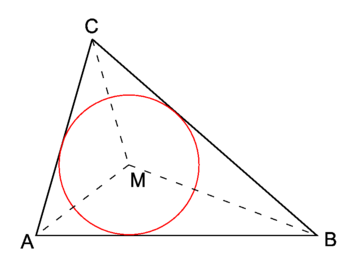Incentre: Difference between revisions
imported>Paul Wormer (Added picture) |
mNo edit summary |
||
| (2 intermediate revisions by 2 users not shown) | |||
| Line 1: | Line 1: | ||
{{subpages}} | {{subpages}} | ||
{{Image|Incircle.png|right|350px|Dashed lines are bisectors of the respective angles, red circle is the incircle with incentre M.}} | |||
In [[triangle geometry]], the '''incentre''' of a triangle is the centre of the | In [[triangle geometry]], the '''incentre''' of a triangle is the centre of the '''incircle''', a [[circle]] which is within the [[triangle]] and [[tangent]] to its three sides. It is the common intersection of the three angle bisectors, which form a [[Cevian line]] system. The '''contact triangle''' has as vertices the three points of contact of the incircle with the three sides: it is the [[pedal triangle]] to the incentre. The '''inradius''' is the radius of the incircle: the area of the triangle is equal to the product of the inradius and the [[semi-perimeter]]. The incircle is tangent to the [[nine-point circle]]. | ||
More generally, if a polygon has a single interior circle tangent to all its sides, this is the incircle of the polygon and the centre of the incircle is the incentre. | More generally, if a polygon has a single interior circle tangent to all its sides, this is the incircle of the polygon and the centre of the incircle is the incentre. | ||
A [[circum quadrilateral]] is a [[quadrilateral]] with an inscribed circle. The condition for a quadrilateral to have an incircle is that the sums of the lengths of the pairs of opposite sides should be equal. | A [[circum quadrilateral]] is a [[quadrilateral]] with an inscribed circle. The condition for a quadrilateral to have an incircle is that the sums of the lengths of the pairs of opposite sides should be equal.[[Category:Suggestion Bot Tag]] | ||
Latest revision as of 16:00, 31 August 2024
In triangle geometry, the incentre of a triangle is the centre of the incircle, a circle which is within the triangle and tangent to its three sides. It is the common intersection of the three angle bisectors, which form a Cevian line system. The contact triangle has as vertices the three points of contact of the incircle with the three sides: it is the pedal triangle to the incentre. The inradius is the radius of the incircle: the area of the triangle is equal to the product of the inradius and the semi-perimeter. The incircle is tangent to the nine-point circle.
More generally, if a polygon has a single interior circle tangent to all its sides, this is the incircle of the polygon and the centre of the incircle is the incentre.
A circum quadrilateral is a quadrilateral with an inscribed circle. The condition for a quadrilateral to have an incircle is that the sums of the lengths of the pairs of opposite sides should be equal.
